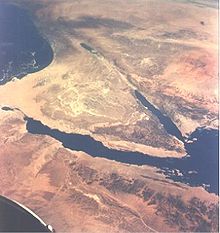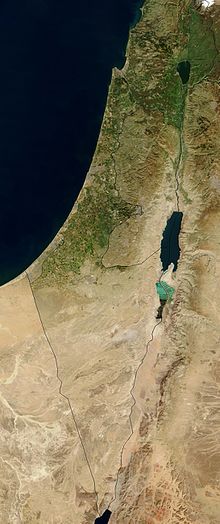Jordan Rift Valley

The Jordan Rift Valley (Arabic: الغور Al-Ghor or Al-Ghawr) is an elongated depression located in modern-day Israel, Jordan, the West Bank and the Golan Heights. This geographic region includes the Jordan River, Hula Valley, Lake Tiberias and the Dead Sea, the lowest land elevation on Earth.
Origins and physical features

The Jordan Rift Valley was formed many million years ago in the Miocene epoch (23.8 - 5.3 Myr ago) when the Arabian tectonic plate moved northward and then eastward away from Africa. One million year later, the land between the Mediterranean and the Jordan Rift Valley rose so that the sea water stopped flooding the area.
The lowest point in the Jordan Rift Valley is at the shores of the Dead Sea, which is also the lowest point (on land) on the surface of the earth at 400 meters below sea level. Rising sharply to almost 1,000 meters in the west, and similarly in the east, the rift is a significant topographic feature over which few narrow paved roads and difficult mountain tracks lead.[1] The valley north of the Dead Sea has long been a site of agriculture because of water available from the Jordan River and numerous springs located on the valley's flanks.
The Dead Sea Transform
The plate boundary which extends through the valley is variously called the Dead Sea Transform or Dead Sea Rift. The boundary separates the Arabian plate from the African plate, connecting the divergent plate boundary in the Red Sea (the Red Sea Rift) to the East Anatolian Fault in Turkey. [2]
The interpretation of the tectonic regime that led to the development of the Dead Sea Transform is highly contested. Some consider it as a transform fault that accommodates a 105 km northwards displacement of the Arabian plate,[3] and trace its structural evolution to the early Miocene. Others presume that the Rift is an incipient oceanic spreading center, the northern extension of the Red Sea Rift,[4] and the displacement along it is oblique, with approximately 10-15 km of extension in addition to the more substantial left lateral (sinistral) strike-slip. The evolution of the rift, according to this latter model, started in the late Miocene with the linear series of basins that propagated gradually along their axes to form the present rift valley.[5] The elucidation of the nature of the Dead Sea Transform/Rift is a matter of ongoing study and discussion.
Population
The Jordanian population of the valley is over 85,000 people,[6] most of whom are farmers, and 80% of the farms in the Jordanian part of the valley are family farms no larger than 30 dunams in size.[7]
Some 47,000 Palestinians live in the part of the valley that lies in the West Bank in about twenty permanent communities, among them the city of Jericho. Thousands of Bedouins also live in temporary communities.[8]
About 11,000 Israelis live in 17 kibbutzim that form part of the Emek HaYarden Regional Council in Israel,[9] while an additional 7,500 live in twenty-six Israeli settlements and five Nahal encampments that have been established in the part of the Jordan Valley that lies in the West Bank.[8]
Prior to the 1967 Six-Day War, the valley's Jordanian side was home to about 60,000 people largely engaged in agriculture and pastoralism.[6] By 1971, the population had declined to 5,000 as a result of the war and the 1970-71 conflict between the Palestinian guerrillas and the Jordanian armed forces.[6] Investments by the Jordanian government in the region allowed the population to rebound to over 85,000 by 1979.[6]
Since the end of the 1967 war, every Israeli government has considered the western Jordan Valley to be the eastern border of Israel with Jordan.[8]
Agriculture
The Jordan River rises from several sources, mainly the Anti-Lebanon Mountains in Syria. It flows down into the Sea of Galilee, 212 meters below sea level, and then drains into the Dead Sea.[10] South of the Dead Sea, the Jordan Valley turns into the hot, dry Arabah valley.[10]
The Jordan Valley is several degrees warmer than adjacent areas, and its year-round agricultural climate, fertile soils and water supply made it a site for agriculture dating to about 10,000 years ago. By about 3000 BCE, produce from the valley was being exported to neighboring regions.[10] The area's fertile lands were chronicled in the Old Testament, and the Jordan River is revered by Christians as the place where John the Baptist baptized Jesus Christ.[10]
In the last few decades, modern methods of farming have vastly expanded the agricultural output of the area.[10] The construction of the East Ghor Canal by Jordan in 1950s (now known as the King Abdullah Canal), which runs down the east bank of the Jordan Valley for 69 kilometers, has brought new areas under irrigation.[10] The introduction of portable greenhouses has brought about a seven-fold increase in productivity, allowing Jordan to export large amounts of fruit and vegetables year-round.[10]
References
- ^ David Eshel (3 May 2006). "Increasing Importance of the Jordan Rift Buffer". Defense Update.
{{cite web}}: Check date values in:|date=(help) - ^ The Geophysical Institute
- ^ e.g. Freund et al., 1970; Jaffe and Garfunkel, 1987
- ^ Horowitz, 2001
- ^ Mart, 1994
- ^ a b c d "Jordan". Country Data. Retrieved 2007-07-10. Cite error: The named reference "Countrydata" was defined multiple times with different content (see the help page).
- ^ Dana Charkasi (31 August 2000). "High tech may water Jordan Valley, but dry up family farming". Jordan Times.
- ^ a b c B'tselem (13 February 2006). "Israel has de facto annexed the Jordan Valley".
- ^ About Emek Hayarden R.C.
- ^ a b c d e f g "Touristic Sites: The Jordan Valley". The Hashemite Kingdom of Jordan.
